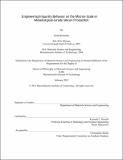| dc.contributor.author | Bernardis, Sarah | en_US |
| dc.contributor.other | Massachusetts Institute of Technology. Department of Materials Science and Engineering. | en_US |
| dc.date.accessioned | 2016-03-03T20:29:45Z | |
| dc.date.available | 2016-03-03T20:29:45Z | |
| dc.date.copyright | 2012 | en_US |
| dc.date.issued | 2012 | en_US |
| dc.identifier.uri | http://hdl.handle.net/1721.1/101457 | |
| dc.description | Thesis: Ph. D., Massachusetts Institute of Technology, Department of Materials Science and Engineering, 2012. | en_US |
| dc.description | This electronic version was submitted by the student author. The certified thesis is available in the Institute Archives and Special Collections. | en_US |
| dc.description | Cataloged from student-submitted PDF version of thesis. | en_US |
| dc.description | Includes bibliographical references (pages 127-137). | en_US |
| dc.description.abstract | Impurities are detrimental to silicon-based solar cells. A deeper understanding of their evolution, microscopic distributions, and oxidation states throughout the refining processes may enable the discovery of novel refining techniques. Using synchrotron-based microprobe techniques and bulk chemical analyses, we investigate Fe, Ti, and Ca starting from silicon- and carbon bearing raw feedstock materials to metallurgical grade silicon (MG-Si), via carbothermic reduction. Before reduction, impurities are present in distinct micron- or sub-micron-sized minerals, frequently located at structural defects in Si-bearing compounds. Chemical states vary, they are generally oxidized (e.g., Fe²+, Fe³+). Impurity concentrations are directly correlated to the geological type of quartz: pegmatitic and hydrothermal quartz have fewer impurities than quartzite. Particles containing Cr, Mn, Fe, Ni, Cu, K, and/or Zn are also detected. In carbon-bearing compounds, Ca typically follows wood veins. In wood, Fe and Ti are diffused uniformly. In contrast, charcoal samples can contain particles of Fe, Ti, and/or Ca. The overall impurity content in the pine charcoal sample is higher than in the pine woodchip, suggesting that the charcoalization process introduces unintentional contamination. During reduction, silica evolution is analyzed in parallel to Fe. Fe is predominantly clustered in minerals which influence its oxidation state. Here, Fe is embedded in muscovite with predominance of Fe℗đ+. Initially, Fe is affected by the decomposition of muscovite and it is found as Fe²+; as muscovite disappears, Fe diffuses in the molten silica, segregating towards interfaces. Contrary to thermodynamic expectation, Fe is oxidized until late in the reduction process as the silica melt protects it from gases present in the furnace, hence minimizing its reduction, only partially measured at high temperatures. After reduction, the initial low- to sub- ppmw concentrations measured in the precursor quartz increase drastically in the MG-Si. The refining process is responsible for the increased contamination. Yet, most impurities are clustered at grain boundaries and a leaching process could remove them. Electrical fragmentation and a leaching treatment are tested as a method to expose grain boundaries of "dirty" quartzite and to remove impurities. The selective fragmentation proves to be a very important step in removing impurities via leaching. | en_US |
| dc.description.statementofresponsibility | by Sarah Bernardis. | en_US |
| dc.format.extent | 137 pages | en_US |
| dc.language.iso | eng | en_US |
| dc.publisher | Massachusetts Institute of Technology | en_US |
| dc.rights | M.I.T. theses are protected by copyright. They may be viewed from this source for any purpose, but reproduction or distribution in any format is prohibited without written permission. See provided URL for inquiries about permission. | en_US |
| dc.rights.uri | http://dspace.mit.edu/handle/1721.1/7582 | en_US |
| dc.subject | Materials Science and Engineering. | en_US |
| dc.title | Engineering impurity behavior on the micron-scale in metallurgical-grade silicon production | en_US |
| dc.type | Thesis | en_US |
| dc.description.degree | Ph. D. | en_US |
| dc.contributor.department | Massachusetts Institute of Technology. Department of Materials Science and Engineering | |
| dc.identifier.oclc | 940567406 | en_US |
